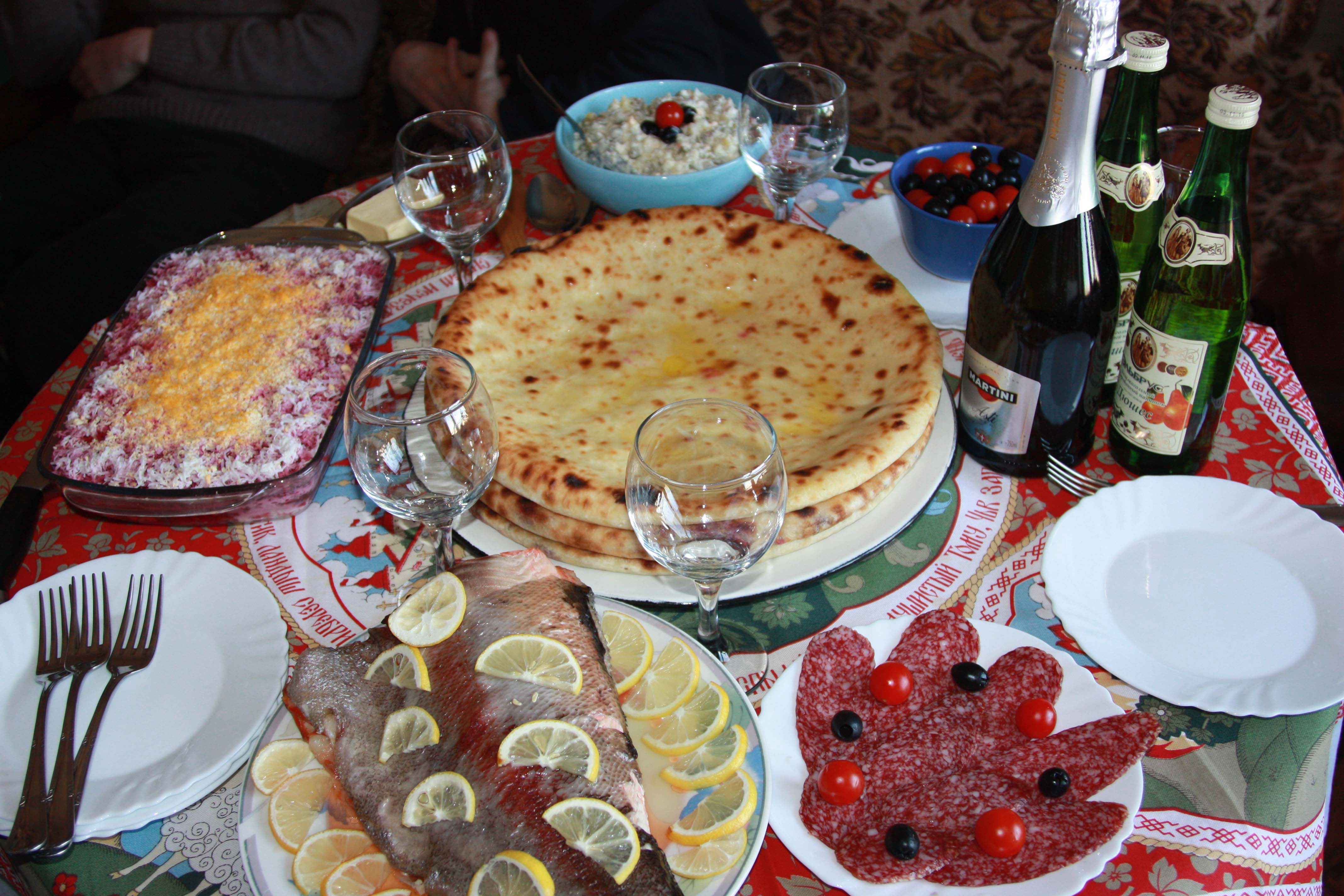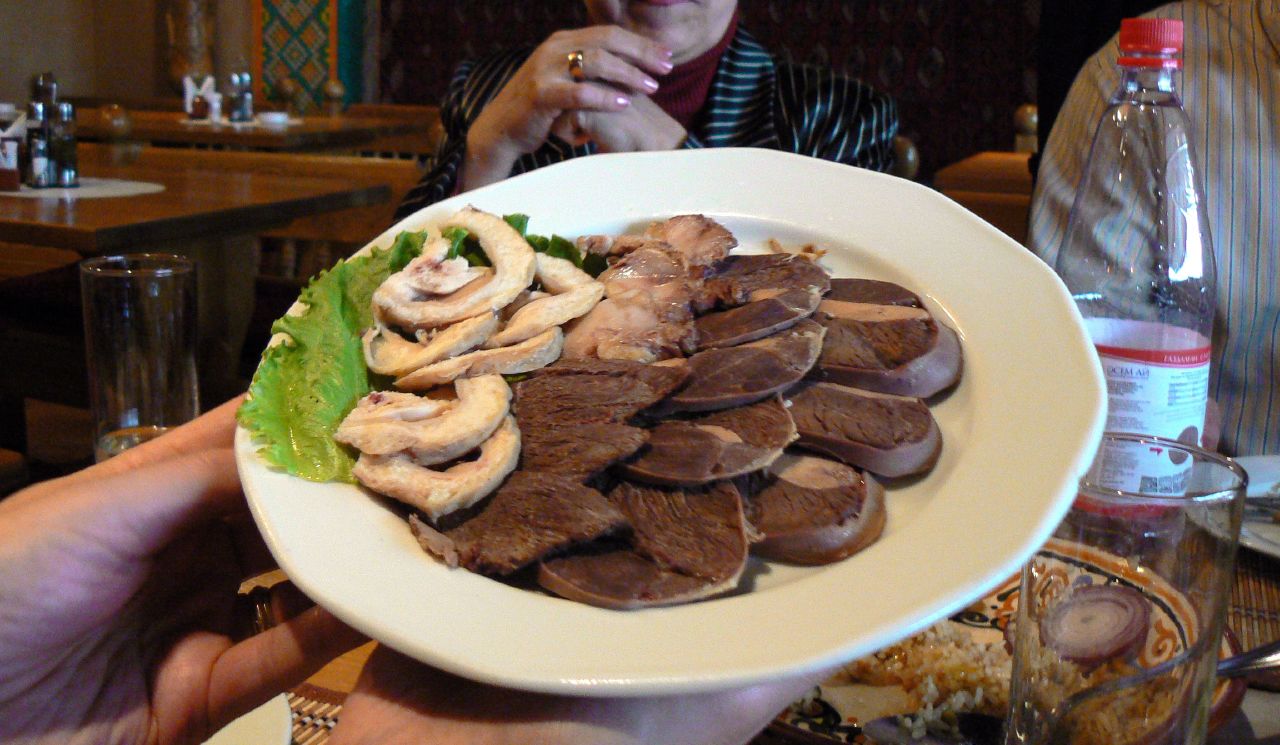|
Soviet Cuisine
Soviet cuisine, the common cuisine of the Soviet Union, was formed by the integration of the various national cuisines of the Soviet Union, in the course of the formation of the Soviet people. It is characterized by a limited number of ingredients and simplified cooking. This type of cuisine was prevalent in canteens everywhere in the Soviet Union. It became an integral part of household cuisine and was used in parallel with national dishes, particularly in large cities. Generally, Soviet cuisine was shaped by Soviet eating habits and a very limited availability of ingredients in most parts of the USSR. Most dishes were simplifications of French, Russian, Austro- Hungarian cuisines, and cuisines from other Eastern Bloc nations. Caucasian cuisines, particularly Georgian cuisine, contributed as well. To a significant extent it was reflected in and formed by '' The Book of Tasty and Healthy Food'', first printed in 1939, following the directions of Anastas Mikoyan. See also * ... [...More Info...] [...Related Items...] OR: [Wikipedia] [Google] [Baidu] |
Cuisine
A cuisine is a style of cooking characterized by distinctive ingredients, List of cooking techniques, techniques and Dish (food), dishes, and usually associated with a specific culture or geographic region. Regional food preparation techniques, customs and ingredients combine to enable dishes unique to a region. Etymology Used in English since the late 18th century, the word cuisine—meaning manner or style of cooking—is borrowed from the French for 'style of cooking' (literally 'kitchen'), as originally derived from Latin ''coquere'', 'to cook'. Influences on cuisine A cuisine is partly determined by ingredients that are available locally or through trade. Regional ingredients are developed and commonly contribute to a regional or national cuisine, such as Japanese rice in Japanese cuisine. Food and drink prohibitions, Religious food laws can also exercise an influence on cuisine, such as Indian cuisine and Hinduism that is mainly lacto-vegetarian (avoiding meat and eggs) ... [...More Info...] [...Related Items...] OR: [Wikipedia] [Google] [Baidu] |
Buryat Cuisine
Buryat cuisine is the traditional cuisine of the Buryats, a Mongols, Mongolic people who mostly live in the Buryat Republic and around Lake Baikal in Russia. Buryat cuisine shares many dishes in common with Mongolian cuisine and has been influenced by Soviet cuisine, Soviet and Russian cuisine. Common dishes Most dishes are lamb and mutton, lamb- or beef-based, but fish dishes are common especially around Lake Baikal. There are also a number of dairy products made by the Buryats. Buryat cuisine is simple and hearty with very little spice. The Buryats, like the Mongols, are known for their buuz, a type of steamed dumpling. Popular Buryat foods * Buuzy (Бузы) also known as Pozy or Buuz in Mongolia, are meat-filled steamed dumplings usually filled with a mixture of either lamb or beef with onions. * Buchler (Бучлер) is a lamb soup with hand cut noodles and potatoes. * Shulep (Шулэн) is a mutton soup with egg noodles and sometimes dumplings. * Bukhelor (Бухел) ... [...More Info...] [...Related Items...] OR: [Wikipedia] [Google] [Baidu] |
Tatar Cuisine
Tatar cuisine is primarily the cuisine of the Volga Tatars, who live in Tatarstan, Russia, and surrounding areas. History The cuisine of the Volga Tatars takes its origin from the cuisine of the Volga Bulgars, who once were nomads, but nearly 1500 years ago turned to agriculture and assimilated into local agricultural societies. Tatar cuisine was influenced by the surrounding peoples – Russians, Mari people, Mari, Udmurts, and also peoples of Central Asia, especially Uzbeks. Dishes such as ''pilaw'' (pilaf), halvah (''xälwä''), and Sharbat (drink), sherbet (') entered long ago into the Tatar culture. Tatars became familiar with many elements of Russian cuisine early in their history. However, culinary influences and greater variety of products have not changed the basic ethnic features of Tatar cuisine but have instead made it more diverse. Geography and nature were also instrumental in the shaping of the Tatar cuisine. The location of the Tatars at the border of two geograp ... [...More Info...] [...Related Items...] OR: [Wikipedia] [Google] [Baidu] |
Tajik Cuisine
Tajik cuisine is a traditional cuisine of Tajikistan, and has much in common with Iranian, Afghan, Russian, Chinese, and Uzbek cuisines. ''Palov'' or ''palav'' (pilaf) (), also called ''osh'' (), is the national dish in Tajikistan, as in other countries in the region. Green tea () is the national drink. Common foods and dishes Palav or osh, generically known as ''plov'' (pilaf), is a rice dish made with julienned carrot, and pieces of meat, all fried together in vegetable oil or mutton fat in a special cookware called ''deg'' (a wok-shaped cauldron) over an open flame. The meat is cubed before or after being cooked, the carrots can be yellow or orange, and the rice is colored yellow or orange by the frying carrots and the oil. The dish is eaten communally from a single large plate placed at the center of the table, often in with one's hands in the traditional way. Another traditional dish that is still eaten with hands from a communal plate is '' qurutob'' (), whose name ... [...More Info...] [...Related Items...] OR: [Wikipedia] [Google] [Baidu] |
Sakha Cuisine
Sakha cuisine () encompasses the customary and traditional cooking techniques and culinary arts of Sakha. Food availability Sakha cuisine is influenced by the area's northern climate and the traditional pastoral lifestyle of the Sakha people, as well as Russian cuisine. Sakha cuisine generally relies heavily on dairy products, meat, fish, and foraged goods. Food is generally prepared through boiling (meat, fish), fermentation (kumis, suorat), or freezing (meat, fish). Dishes One of the best-known Sakha dishes is ''stroganina'', thin slices of raw, frozen fish. However, ''stroganina'' is also prepared using foal meat and liver. This is eaten with a spicy seasoning from a flask. Another popular fish dish is ''indigirka'', consisting of frozen fish cubes seasoned with onions, salt, pepper, and more. Milk is drunk and also used to make butter, curds, and a thick yogurt called ''suorat''. A popular dish is ''khaan'', a type of blood sausage made from horse or beef blood and ... [...More Info...] [...Related Items...] OR: [Wikipedia] [Google] [Baidu] |
Russian Cuisine
Russian cuisine is a collection of the different dishes and cooking traditions of the Russians, Russian people as well as a list of culinary products popular in Russia, with most names being known since pre-Soviet times, coming from all kinds of social circles. History The history of Russian cuisine was divided in four groups: Old Russian cuisine (9th to 16th century), Old Moscow cuisine (17th century), the cuisine that existed during the ruling of Peter the Great, Peter and Catherine the Great (18th century), and finally Petersburg cuisine, which took place from the end of the 18th century to the 1860s. In the Old Russian period, the main food groups were bread, grains, and other foods that contained starch. Women baked pies with many different fillings, such as mushrooms or berries. During gatherings, a loaf of bread and salt was always present. Kasha, such as buckwheat and oats, were represented as wellbeing to the household. Many Russians used honey and berries and mad ... [...More Info...] [...Related Items...] OR: [Wikipedia] [Google] [Baidu] |
Ossetian Cuisine
Ossetian cuisine () refers to the cooking styles and dishes of the Ossetians of the Caucasus. Ossetian pie Fidgin/fуddžyn () is a type of meat pie. Three pies () is an important concept in Ossetian culture, representing sun, earth and water. Ossetian beer Beer has been prepared and enjoyed in Ossetia since ancient times. Ossetian beer is dark-brown to black in color, has little-to-no foam and a significantly lower alcohol content than most ordinary types of beer. Iron Bægæny is a famous beer festival celebrating this cultural treasure in a manner comparable to that of the German Oktoberfest. Ossetian cheese Ossetian cheese is a traditional cheese of Ossetians. It is mostly served as hard cheese. South Ossetian dishes A dish unique to South Ossetia—similar to a Scotch egg or nargesi kebab—is made by wrapping one half of a boiled egg in a serving of ground beef and frying it in tomato sauce Tomato sauce (; ; ) can refer to many different sauces made ... [...More Info...] [...Related Items...] OR: [Wikipedia] [Google] [Baidu] |
Mordovian Cuisine
Mordovian cuisine is the traditional cuisine of the Mordovians, who now live in Mordovia and surrounding areas. It consists of a variety of dishes, based on geographical, cultural and climate features of the region, with fish traditionally featured heavily. Fish Volga Finns settled on the riversides, in places convenient for fishing. Traditionally Mordovians pay a great attention to the support of nature. Fish dishes varied by the type of cooking; fish was eaten raw, frozen, dried, salty, and boiled. Fish liver, fish eggs, milt, cod-liver oil were used as cooking ingredients. Meat Meat and poultry was stewed, baked and boiled. There were no fried meat dishes in Finno-Ugric cuisine, only roasted dishes which also were borrowed from Tatar cuisine in the 19th century. Beef, mutton and pork were preserved in several ways. The most ancient preservation method was drying. Pre-boiled meat was dried in an oven or under the sun. Fat from broth was collected and used for cooking. Meat ... [...More Info...] [...Related Items...] OR: [Wikipedia] [Google] [Baidu] |
Moldovan Cuisine
Moldovan cuisine is a style of cooking related to the people of Moldova. It consists mainly of ingredients such as various meats, potatoes, cabbage, and a variety of cereal grains. The local cuisine is very similar to Romanian cuisine, Romanian, and also draws inspiration and elements from other cuisines in the region, including Greek cuisine, Greek, Polish cuisine, Polish, Ukrainian cuisine, Ukrainian, and Russian cuisine, Russian, with a great influence left by the Ottoman cuisine. With the cuisine of Moldova being shared by another country, namely Romanian cuisine, there are similarities to these two cuisines of the two Romanian-speaking countries. Background Moldova's fertile soil (''chernozem'') produces plentiful grapes, fruits, vegetables, Food grain, grains, meat, and milk products, all of which have found their uses in the national cuisine. The fertile black soil combined with the use of traditional agricultural methods permits the growth of a wide range of foods in ... [...More Info...] [...Related Items...] OR: [Wikipedia] [Google] [Baidu] |
Kyrgyz Cuisine
Kyrgyz cuisine is the cuisine of the Kyrgyz, who comprise a majority of the population of Kyrgyzstan. The cuisine is similar in many aspects to that of their neighbors. Traditional Kyrgyz food revolves around mutton, beef and horse meat, as well as various dairy products. The preparation techniques and major ingredients have been strongly influenced by the nation's historically nomadic way of life. Thus, many cooking techniques are conducive to the long-term preservation of food. Mutton and beef are the favorite meats, although in modern times many Kyrgyz are unable to afford them regularly. Kyrgyzstan is home to many different nationalities and their various cuisines. In larger cities, such as Bishkek, Osh, Jalal-Abad, and Karakol, various national and international cuisines can be found. Non-Kyrgyz cuisines that are particularly common and popular in Kyrgyzstan include Uyghur, Dungan, Uzbek, and Turkish cuisines, representing the largest minorities in the country. ... [...More Info...] [...Related Items...] OR: [Wikipedia] [Google] [Baidu] |
Komi Cuisine
Komi cuisine consists of the cuisine of the Komi Republic and the Komi peoples, and is characterized by the rich use of local foods. Significant differences separate Komis' dining tendencies in the northern and southern regions of their homeland. In the northern reindeer herding and hunting areas, meat is eaten daily, but it is not in the more agricultural south. In the south, fish is commonly eaten; hogs and poultry are eaten less often. Komi women bake fish pie () on festive family occasions. The Fish Pie Festival () is held annually on the last Sunday of June in the village of Byzovaya, Pechora Pechora (; ) is a types of inhabited localities in Russia, town in the Komi Republic, Russia, located on the Pechora (river), Pechora River, west of and near the northern Ural Mountains. The area of the town is . Population: History Pechor ... Raion. References Komi Republic Russian cuisine {{cuisine-stub ... [...More Info...] [...Related Items...] OR: [Wikipedia] [Google] [Baidu] |
Kazakh Cuisine
Traditional Kazakh cuisine is the traditional food of the Kazakh people. It is focused on mutton and horse meat, as well as various Dairy products, milk products. For hundreds of years, Kazakhs were herders who raised fat-tailed sheep, Bactrian camels, and horses, relying on these animals for transportation, clothing, and food. The cooking techniques and major ingredients have been strongly influenced by the nation's nomadic way of life. For example, most cooking techniques are aimed at long-term Food preservation, preservation of food. There is a large practice of salting and drying meat so that it will last, and there is a preference for sour milk, as it is easier to save in a nomadic lifestyle. Meat in various forms has always been the primary ingredient of Kazakh cuisine, and traditional Kazakh cooking is based on boiling. Horse and mutton are the most popular forms of meat and are most often served in large uncut pieces which have been boiled. Kazakhs cared especially for hor ... [...More Info...] [...Related Items...] OR: [Wikipedia] [Google] [Baidu] |






